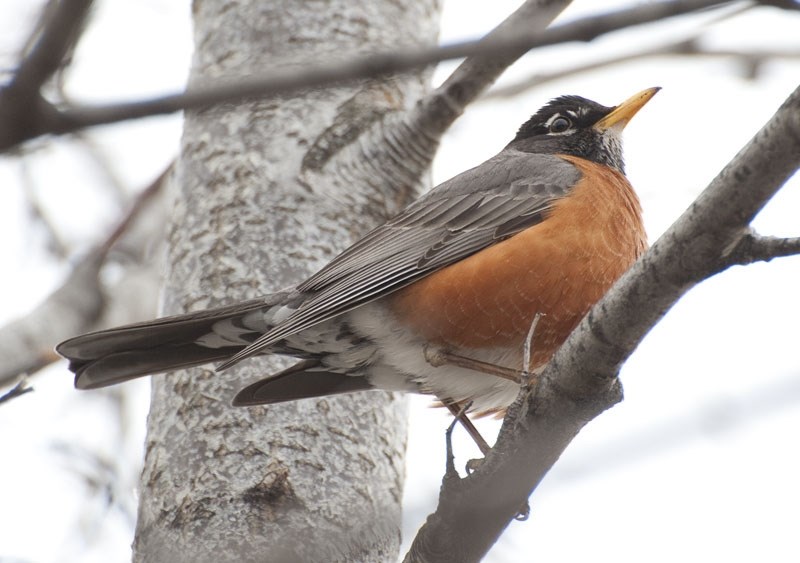It's technically springtime in St. Albert, despite all the snow, and that technically means the return of the cheeriest of springtime birds, the American robin. I say "technically" because the robins never really left.
It's technically springtime in St. Albert, despite all the snow, and that technically means the return of the cheeriest of springtime birds, the American robin.
I say "technically" because the robins never really left. American robins have shown up in St. Albert's Christmas Bird Count as early as 1991, reports count-co-ordinator Alan Hingston, and have been spotted in every count since 1999. Seven were spotted in town during the most recent count.
But they tend not to show up en masse until around the middle of April, says birder Dan Stoker. About 422 showed up out of nowhere at the Big Lake Environment Support Society's viewing platform during the 2011 Springing to Life event, he recalls, which is held in mid-April. "It was something I won't forget."
Most people can easily spot a robin, Stoker says, as they're so closely associated with urban lawns. Look for a bird that's about twice the size of a sparrow with a ruddy orange breast and a slate-grey or black back and head.
You can also listen for their classic "cheerily cheer-up cheerio" song, adds John "the Nature Nut" Acorn, renewable resources instructor at the University of Alberta, which they use to demarcate territory and attract mates. (If you hear an incessantly cheery bird that never seems to shut up, it's probably a robin.)
Birders might mix up the American robin with the varied thrush, Acorn says, which has a black band over its orange chest, or the pine grosbeak, which is pinkish-red. They're unlikely to confuse it with the European robin, which is about half as big, has a brown back and is not found on this continent. "Ours is a big fancy handsome bird. Theirs is just sort of little and cute."
Robins prefer to eat insects, particularly worms, Acorn notes, which are surprisingly easy to see and hear when you're about five centimetres above the ground. Most will be pigging out on berries at this time of year, and will stick around all winter if they find enough food to eat.
During mating, reports Hinterland Who's Who, male robins will typically fight with each other over females, who they will attempt to woo with songs, gifts of food and open-beaked "kisses."
You might see robins aggressively attacking your windows as well, Stoker says, as they try to fend off the nefarious mirror-birds invading their territory. Try closing blinds or putting up decals if you notice a robin going 12 rounds with its own reflection, he suggests.
Expect couples to start making bowl-shaped nests from mud and grass in a few weeks, Acorn says. "They like to nest on shelves," he notes, which means they can sometimes set up shop in very public places, such as near your front door.
Stoker says the grassy ponds in his yard are magnets for robins. "They come in and they fill up their beaks with as much as they can, and take off, trailing bits of grass."
Those same birds often return with their chests covered in mud, he continues, since they squish the mud into the proper shape using their breasts. Once hardened, the nests are extremely durable. "You practically have to crack it apart."
Robins can breed several times a year, Acorn says, and typically have three-to-five chicks at a time. As these chicks typically leave the nest before they can fly, they're exceptionally vulnerable to cats, merlins and coyotes. Maybe 25 per cent will live to see November, Hinterland Who's Who notes.
Traditional feeders won't work on robins, Stoker says, as they prefer to eat bugs on the ground. Berry trees will attract robins (who can sometimes clean them out before the bohemian waxwings arrive), as will sources of water, grass and mud.
Backyard gardens make for ideal robin habitats with their berry trees and earthworms, Acorn says, so it's no wonder that these birds tend to hang around them. "They're a perfect little companion for humanity."
American robin
Name: <br />Turdus migratorius.<br />
Appearance: <br />Ruddy-orange breasted bird with grey/black back and head, yellow beak, about twice the size of a sparrow.<br />
Commonly seen:<br />Hopping along, looking for worms, or perched on a tree, singing incessantly.
Occasionally confused with:<br />The varied thrush, which has a black band on its orange chest, and the pine grosbeak, which is pinkish red.<br />
Fun fact: <br />They roost together by the hundreds during migration, with some roosts numbering in the hundreds of thousands.
Wild St. Albert
Like wildlife? So do we! Every second Wednesday the Gazette profiles a reasonably common wild creature in the St. Albert region. Birds, beasts, bugs, fish … so long as it's alive and kicking, we'll feature it. <br /><br />Got a creature you'd like to see profiled? Send your suggestions to [email protected].




